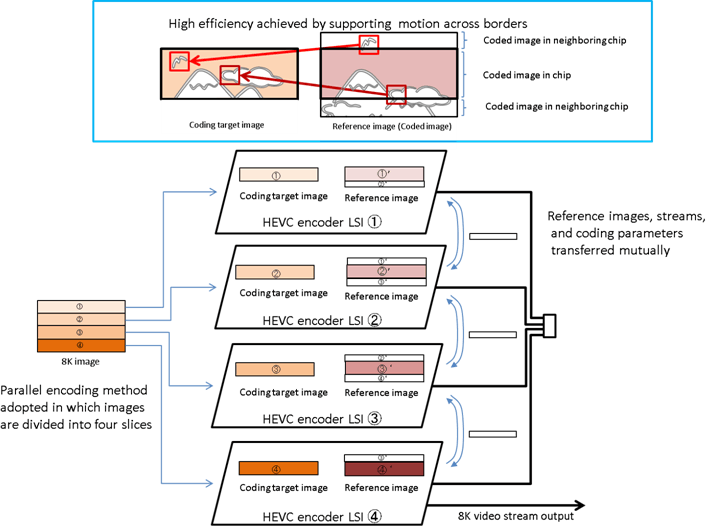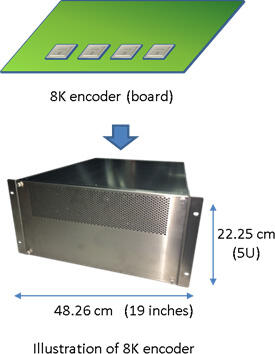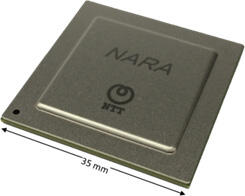Microsoft ends support for Internet Explorer on June 16, 2022.
We recommend using one of the browsers listed below.
- Microsoft Edge(Latest version)
- Mozilla Firefox(Latest version)
- Google Chrome(Latest version)
- Apple Safari(Latest version)
Please contact your browser provider for download and installation instructions.
February 15, 2016
NTT develops the worlds' best performance 8K HEVC real-time encoder through dedicated LSI use - enabling immersive high-quality 8K video transmission at 85 Mbps -
Nippon Telegraph and Telephone (NTT) Corporation (Head office, Chiyoda-ku, Tokyo, Japan; Hiroo Unoura, President and CEO) has developed the worlds' best performance high-quality 8K HEVC real-time encoder through the use of dedicated LSI's, which is the key to immersive high-quality 8K video services.
In March 2015, NTT announced a real-time 4K/60p*1 ultra-high definition video encoder LSI (NARA*2) that conforms with H.265/HEVC*3 (hereafter HEVC), the latest international video coding standard. NTT has developed a high-quality and high-efficiency 8K/60p*4 HEVC real-time encoder operating in conjunction with four LSIs and performing mutual data transmission between them.
This 8K encoder enables immersive high-quality 8K video transmission at 85 Mbps and also enables the 8K encoding process to become economically feasible on one board. This accelerates 8K video distribution services, such as public viewing and ODS*5, and 8K broadcast services, and contributes to new application creation in the medical and surveillance fields.
1.Development Background
Recently, ultra-high definition 4K video services with high realistic sensation have attracted attention. The NTT group has been participating in Japanese government-related business projects and working towards the promotion of ultra-high definition 4K/8K video services. From 2015 on 4K video services, such as satellite broadcasting, IPTV and CATV services, started to become widespread. But 8K video has four times as many pixels as 4K video and thus provides greater reality. It therefore requires a real-time encoder that not only has high compression efficiency but is also small and economical.
NTT laboratories have been researching and developing the technologies needed for 8K video services to become widespread. These technologies are based on those that have been cultivated in the development of encoder LSIs. (See Attachment 1)
2.Technical Points
NTT laboratories have developed the worlds' best performance high-quality 8K HEVC real-time encoder by using four chips of the HEVC real-time encoder LSI (NARA). The encoder was developed in order to enable high-quality 8K video services with high realistic sensation.
The encoder's technical points are described below
(1)Highly efficient, high-quality encoding enabled by mutual data transfer among chips
This 8K encoder adopts a parallel encoding method in which 7,680 × 4,320 pixel images are divided into four images. The encoder LSIs, which are capable of 4K image processing, then encode the divided images in parallel. Video coding methods, including HEVC, generally reduce the amount of information by obtaining the difference between an input image and a coded image (reference image) in accordance with image motion. In this encoder the encoding, which covers the motion across the border of divided images, is achieved by transferring reference images among four chips. This enables high coding efficiency and prevents degradation (Fig. 1).
Data transfer in the encoder also enables other processes to be carried out, including filter de-blocking across image borders and rate control that unifies image quality between divided images. These processes enable high-quality 8K video transmission at 85 Mbps, in contrast to the H.264 standard whose required bitrate is 200-160 Mbps.
A previous example was cited in which 8K encoding was achieved in real time by parallel processing through 4K capable encoder LSIs. However, its coding efficiency and image quality were not good enough because it does not involve data transfer among chips. In another example 8K video was encoded by multiple FPGA*6 based encoder boards involving mutual data transfer. Now, however, higher image quality and more efficient encoding is achieved by using four dedicated encoder LSIs with higher processing performance.
 (Fig. 1)
(Fig. 1)
(2)Smaller size and more economical 8K video encoder (Fig. 2)
In this encoder, 8K real-time encoding is performed on one board on which four HEVC encoder LSIs and peripheral circuit are mounted. Multiple encoder boards have been required previously. The encoder's size, about 5U (22.25 cm height) at 19 inch rack width makes it significantly smaller and more economical than previous encoders.
 (Fig. 2)
(Fig. 2)
3.Future Plans
NTT is planning to proceed with trial experiments of ultra-high definition 8K video distribution services including public viewing, ODS, and medical field applications. It is forecast that by 2020 viewers from around the world will be able to watch and enjoy sports events by utilizing these services. NTT will contribute to realize various high-definition and immersive video services by utilizing this technology.
(Reference)
The developed technology is being exhibited at NTT R&D Forum 2016, held February 18-19, 2016.
"NTT R&D forum 2016" https://labevent.ecl.ntt.co.jp/forum2016/e/index.html
Glossary
*14K/60p images
These are ultra-high definition video images with higher resolution than that of current digital broadcasts of HDTV. The resolution of 4K is 3840 × 2160 pixels. The 60p shows frame frequency in the time direction, indicating that the video comprises 60 images per second in progressive scanning. This is four times greater than for HDTV in the spatial direction and double the number in the temporal direction, so there are eight times as many pixels as there are in HDTV.
*2NARA
This is a development code name, an abbreviation of "Next-generation Encoder Architecture for Real time HEVC Applications"
*3H.265/HEVC (High Efficiency Video Coding)
This is the latest video compression standard, developed in April 2014 through collaboration between ITU-T and ISO/IEC.
*48K/60p images
These images have even higher resolution than 4K images. The resolution is 7860 × 4320 pixels and frame frequency is 60 images per second in progressive scanning. In the spatial direction they have four times as many pixels as 4K images.
*5ODS (Other Digital Stuff/Other Digital Sources)
This is for screening contents other than those of movies, such as those of live sports events, concerts, and theatrical performances brought to the big screen through the use of cinema screening equipment.
*6FPGA (Field Programmable Gate Array)
These are programmable LSIs (large scale integrated circuits) that make it possible to change circuit configurations. They have higher development flexibility than dedicated LSIs but their device sizes are larger.
Attachment 1
Past Development of Encoder LSIs in NTT
To achieve high quality video transmission and distribution services, NTT laboratories have developed the following:
- The world's first single-chip MPEG-2*1 HDTV CODEC LSI "VASA" in the summer of 2002
The VASA technology has been adopted in LSIs supporting the terrestrial digital TV broadcasting service started in December 2003 and utilized in the essential devices of various sorts of broadcasting equipment such as MPEG-2 encoders and digital TV relaying networks. - H.264/AVC*2 (hereafter H.264) CODEC LSI "SARA" in the spring of 2007 for professional high-quality broadcasting and distribution use
The SARA technology has also been adopted in real time transcoders that transcode MPEG-2 to H.264 for IP simulcast services of terrestrial and BS digital TV broadcasting. Both technologies are widely utilized as key components for video transmission services. - The world's first professional 4K H.265/HEVC real time encoder LSI "NARA" in April 2015.
The NARA technology has been adopted in encoders for 4K IP broadcasting*3, which started in 2015, and for other purposes. It has become a key device for 4K video services.
 < HEVC real-time encoder LSI (NARA) >
< HEVC real-time encoder LSI (NARA) >
*1MPEG-2(Moving Picture Experts Group-2)
MPEG is an international standard related to the compression of video images. MPEG-2 is a standard encoding method for high-quality video, including HDTV and other TV images, and is also used for DVD and digital TV broadcasting.
*2H.264/AVC (Advanced Video Coding)
This is a video compression standard developed in 2003 through ITU/ISO collaboration. Typical applications of the H.264 compression scheme include Blu-ray Disc and broadcasting for mobile phones (ONE-SEG).
*34K IP broadcasting
NTT Plala Inc. and I-Cast, Inc. Press Release.
http://www.nttplala.com/news_releases/2015/11/20151117_1.html(Japanese)
For further information, please contact:
Nippon Telegraph and Telephone Corporation
NTT Service Innovation Laboratory Group
E-mail: randd@lab.ntt.co.jp
Information is current as of the date of issue of the individual press release.
Please be advised that information may be outdated after that point.
NTT STORY
WEB media that thinks about the future with NTT











